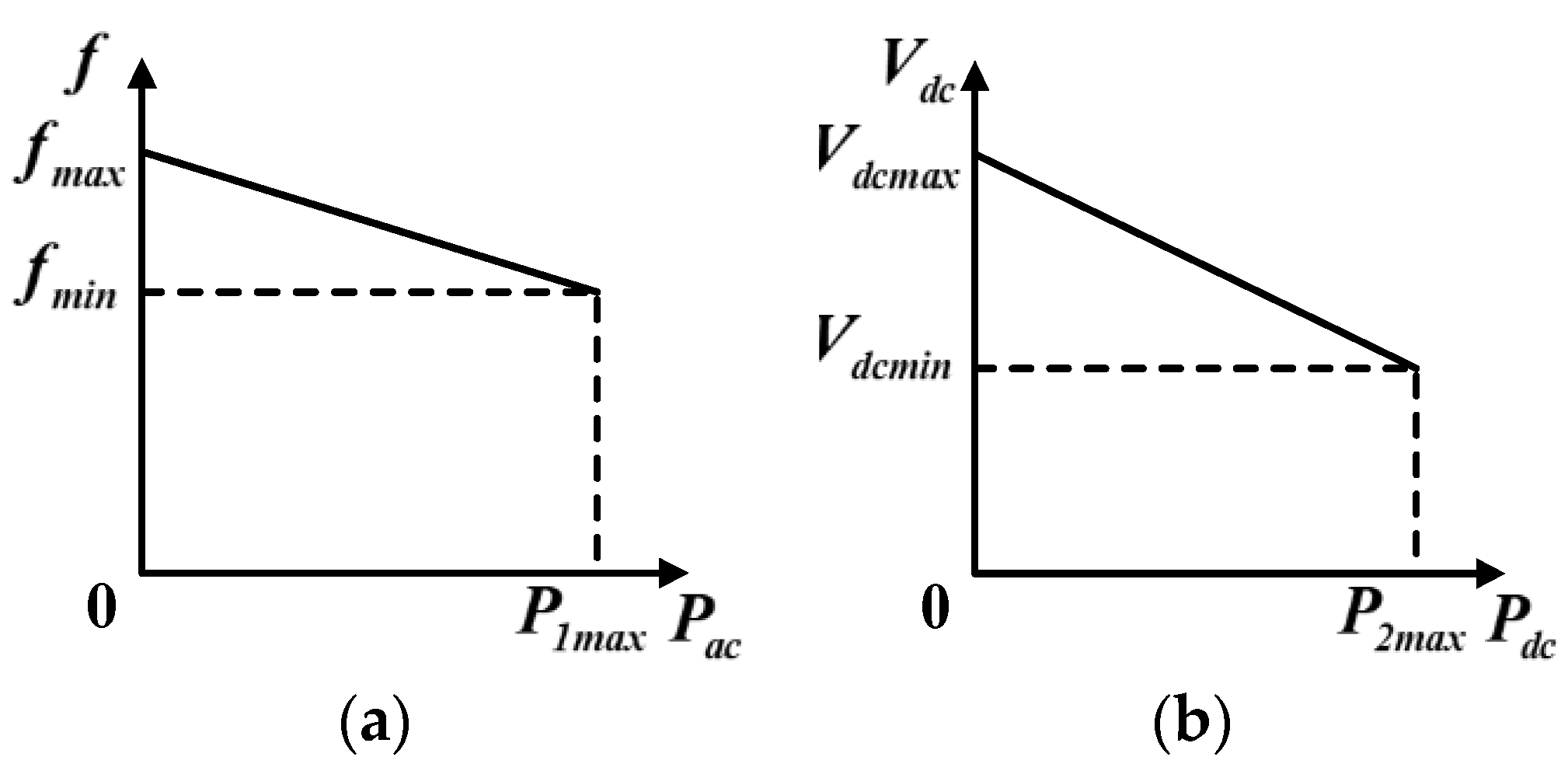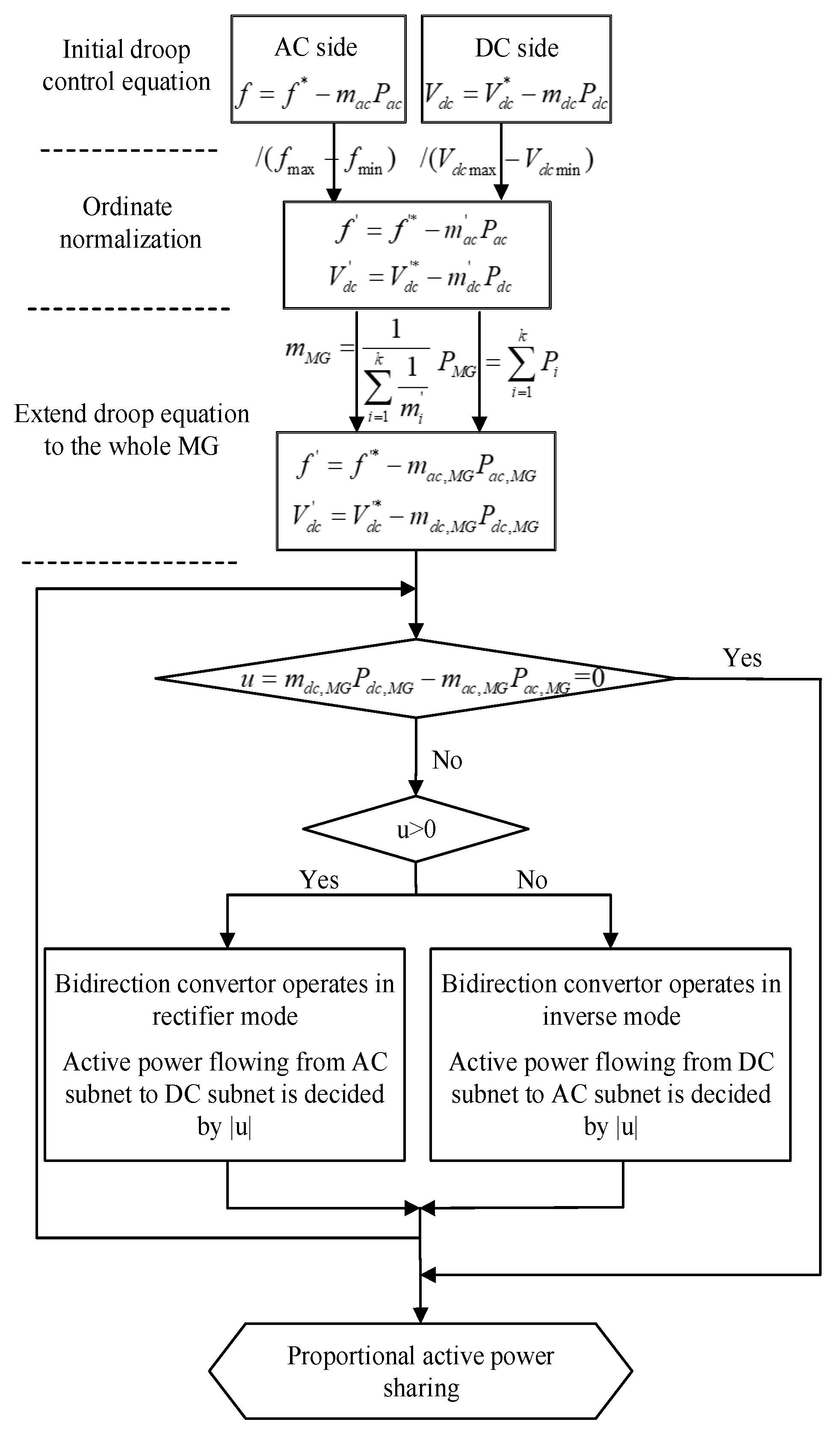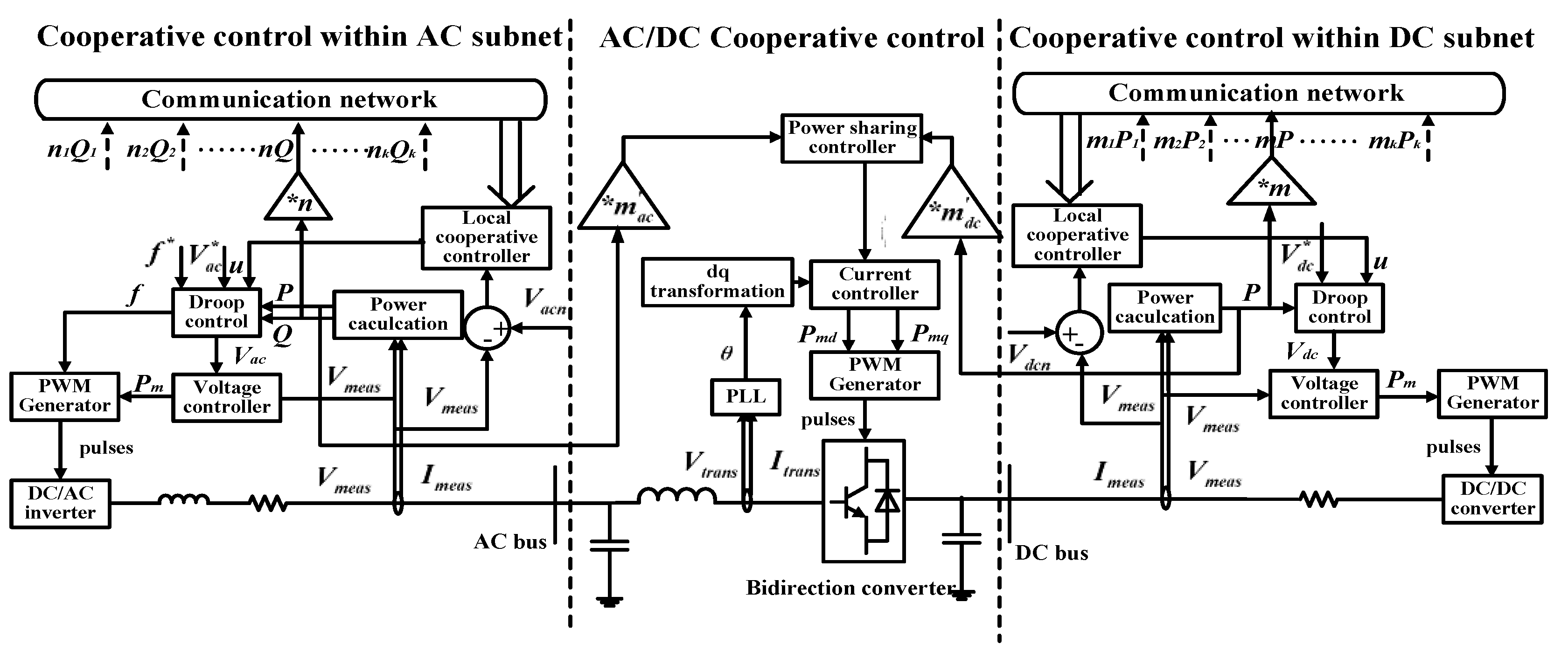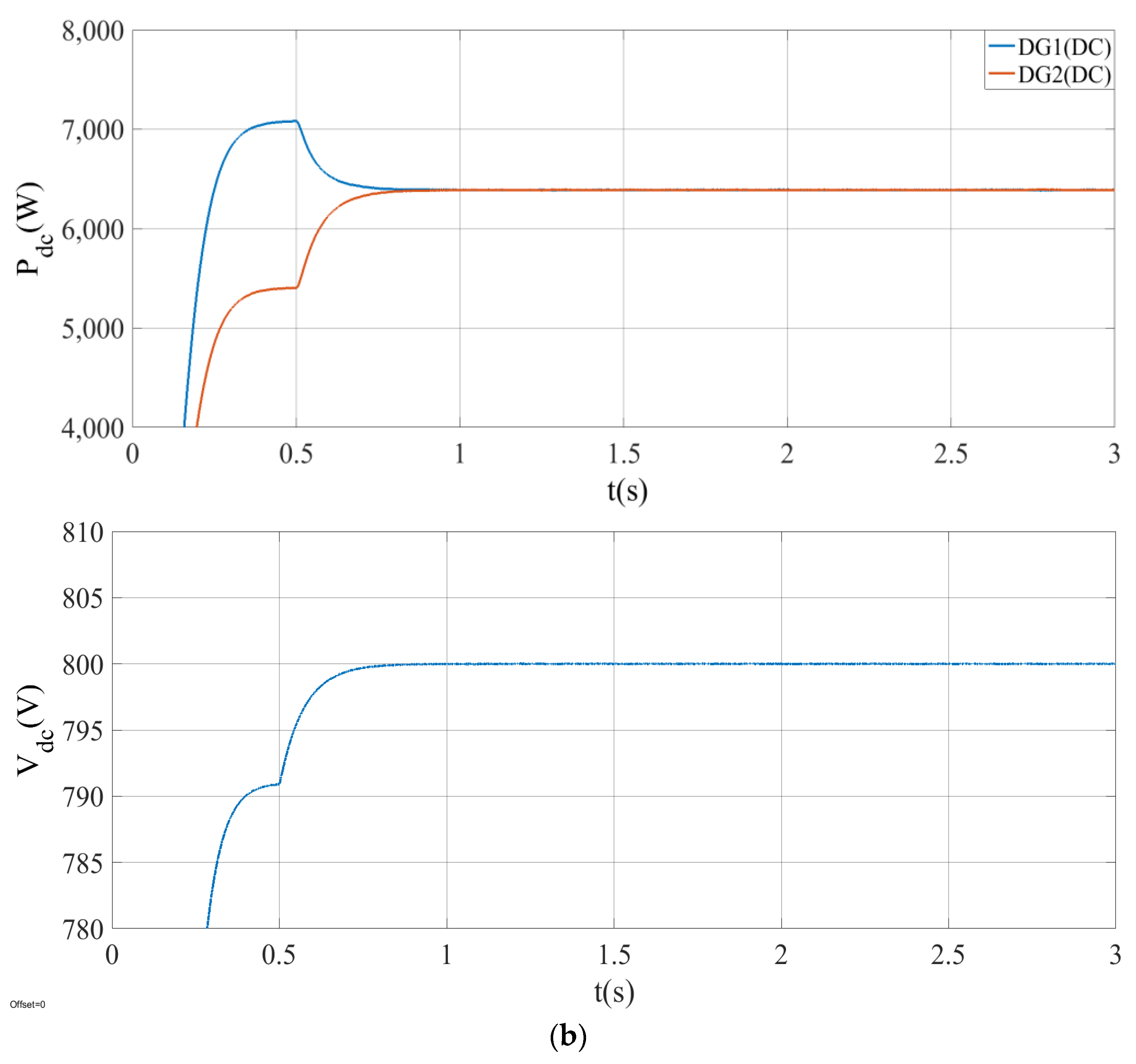A Cooperative Control Scheme for AC/DC Hybrid Autonomous Microgrids
Abstract
:1. Introduction
2. Basic Control Theory of the Microgrid
2.1. Configuration of AC/DC Hybrid Microgrids
2.2. Primary Droop Control
2.3. Cooperative Secondary Control
3. Cooperative Control Strategy of the AC/DC Converter
3.1. Control Theory
3.2. Overall Control Structure of the System
4. Simulation Results
4.1. Cooperative Control within Subnets
4.2. Cooperative Control within Subnets
5. Conclusions
Author Contributions
Funding
Conflicts of Interest
References
- Eghtedarpour, N.; Farjah, E. Power Control and Management in a Hybrid AC/DC Microgrid. IEEE T Smart Grid 2014, 5, 1494–1505. [Google Scholar] [CrossRef]
- Nejabatkhah, F.; Li, Y.W. Overview of Power Management Strategies of Hybrid AC/DC Microgrid. IEEE Trans. Power Electron. 2015, 30, 7072–7089. [Google Scholar] [CrossRef]
- Karimi, M.; Azizipanah-Abarghooee, R.; Uppal, H. Smart integrated adaptive centralized controller for islanded microgrids under minimized load shedding. In Proceedings of the 2017 5th International Istanbul Smart Grid and Cities Congress and Fair, Istanbul, Turkey, 19–21 April 2017. [Google Scholar]
- Abdelaziz, M.M.A.; Shaaban, M.F.; Farag, H.E. A Multistage Centralized Control Scheme for Islanded Microgrids with PEVs. IEEE Trans. Sustain. Energy 2014, 5, 927–937. [Google Scholar] [CrossRef]
- Lou, G.N.; Gu, W.; Xu, Y.L. Distributed MPC-Based Secondary Voltage Control Scheme for Autonomous Droop-Controlled Microgrids. IEEE Trans. Sustain. Energy 2017, 8, 792–804. [Google Scholar] [CrossRef]
- Shayanfar, H.A.; Malek, S. Photovoltaic microgrids control by the cooperative control of multi-agent systems. In Proceedings of the 2015 30th International Power System Conference, Tehran, Iran, 23–25 November 2015. [Google Scholar]
- Luo, S.N.; Hu, C.B.; Zhang, Y.C. Multi-agent systems using model predictive control for coordinative optimization control of microgrid. In Proceedings of the 2017 20th International Conference on Electrical Machines and Systems, Sydney, NSW, Australia, 11–14 August 2017. [Google Scholar]
- Dehkordi, N.M.; Sadati, N. Fully Distributed Cooperative Secondary Frequency and Voltage Control of Islanded Microgrids. IEEE Trans. Energy Convers. 2017, 32, 675–685. [Google Scholar] [CrossRef]
- Dou, C.; Yue, D.; Zhang, Z.; Ma, K. MAS-Based Distributed Cooperative Control for DC Microgrid Through Switching Topology Communication Network With Time-Varying Delays. IEEE Syst. J. 2019, 13, 615–623. [Google Scholar] [CrossRef]
- Guo, F.H.; Xu, Q.W.; Wen, C.Y.; Wang, L.; Wang, P. Distributed Secondary Control for Power Allocation and Voltage Restoration in Islanded DC Microgrids. IEEE Trans. Sustain. Energy 2018, 9, 1857–1869. [Google Scholar] [CrossRef]
- Park, S.H.; Choi, J.Y.; Won, D.J. Cooperative control between the distributed energy resources in AC/DC hybrid microgrid. In Proceedings of the ISGT 2014, Washington, DC, USA, 19–22 February 2014. [Google Scholar]
- Ji, Y.; Wu, M.; Liu, H.T. Bidirectional Droop Control of Interlinking Converter in AC/DC Hybrid Micro-grid. In Proceedings of the 2016 3rd International Conference on Information Science and Control Engineering, Beijing, China, 8–10 July 2016. [Google Scholar]
- Hu, W.Y.; Chen, H.K.; Yang, X.N. Control strategy of the bi-directional converter for hybrid AC/DC microgrid. In Proceedings of the 2015 IEEE PES Asia-Pacific Power and Energy Engineering Conference, Brisbane, QLD, Australia, 15–18 November 2015. [Google Scholar]
- Li, X.L.; Guo, L.; Li, Y.W. A Unified Control for the DC–AC Interlinking Converters in Hybrid AC/DC Microgrids. IEEE T Smart Grid 2018, 9, 6540–6553. [Google Scholar] [CrossRef]
- Wang, J.; Jin, C.; Wang, P. A Uniform Control Strategy for the Interlinking Converter in Hierarchical Controlled Hybrid AC/DC Microgrids. IEEE Trans. Ind. Electron. 2018, 65, 6188–6197. [Google Scholar] [CrossRef]
- Zhang, B.F.; Cao, G.D.; Ren, C.G. Autonomous Control Strategy of Bidirectional AC/DC Converter in Low Voltage Hybrid Microgrid. In Proceedings of the 2017 12th IEEE Conference on Industrial Electronics and Applications, Siem Reap, Cambodia, 18–20 June 2017. [Google Scholar]
- Loh, P.C.; Li, D.; Chai, Y.K.; Blaabjerg, F. Autonomous Control of Interlinking Converter with Energy Storage in Hybrid AC–DC Microgrid. IEEE Trans. Ind. Appl. 2013, 49, 1374–1382. [Google Scholar] [CrossRef]
- Zhong, Q.C. Robust droop controller for accurate proportional load sharing among inverters operated in parallel. IEEE Trans. Ind. Electron. 2013, 60, 1281–1290. [Google Scholar] [CrossRef]
- Lou, G.N.; Gu, W.; Wang, J.H. Optimal Design for Distributed Secondary Voltage Control in Islanded Microgrids: Communication Topology and Controller. IEEE Trans. Power Syst. 2019, 34, 968–981. [Google Scholar] [CrossRef]
- Zhou, J.G.; Zhang, H.G.; Sun, Q.Y. Event-Based Distributed Active Power Sharing Control for Interconnected AC and DC Microgrids. IEEE T Smart Grid 2018, 9, 6815–6828. [Google Scholar] [CrossRef]
- Liu, Z.W.; Miao, S.H.; Kang, Y.L. A bidirectional droop control strategy for the hybrid microgrid with AC/DC distributed generation integration. In Proceedings of the 2018 13th IEEE Conference on Industrial Electronics and Applications, Wuhan, China, 31 May–2 June 2018. [Google Scholar]
- Lou, G.N.; Gu, W.; Xu, Y.L. Stability Robustness for Secondary Voltage Control in Autonomous Microgrids With Consideration of Communication Delays. IEEE Trans. Power Syst. 2018, 33, 4164–4178. [Google Scholar] [CrossRef]
- Xiao, F.; Shi, Y.; Ren, W. Robustness Analysis of Asynchronous Sampled-Data Multiagent Networks With Time-Varying Delays. IEEE Trans. Autom. Control. 2018, 63, 2145–2152. [Google Scholar] [CrossRef] [Green Version]
- Zhan, J.; Li, X. Asynchronous Consensus of Multiple Double-Integrator Agents With Arbitrary Sampling Intervals and Communication Delays. IEEE Trans. Circuits Syst. I Regul. Pap. 2015, 62, 2301–2311. [Google Scholar] [CrossRef]












| AC Side | DC Side | |||
|---|---|---|---|---|
| Rated Value | Voltage | 380 V/50 Hz | Voltage | 800 V |
| Power of DG1–3 | 20 kW | Power of DG1–2 | 80 kW | |
| 38 kvar | ||||
| Droop Coefficient | 1 × 10−5 | 1 × 10−3 | ||
| 1 × 10−3 | ||||
| Output Impendence | Z1 | 0.05 + 0.126 j | R1 | 0.15 |
| Z2 | 0.1 + 0.283 j | |||
| R2 | 0.2 | |||
| Z3 | 0.07 + 0.157 j | |||
© 2020 by the authors. Licensee MDPI, Basel, Switzerland. This article is an open access article distributed under the terms and conditions of the Creative Commons Attribution (CC BY) license (http://creativecommons.org/licenses/by/4.0/).
Share and Cite
Sheng, W.; Hong, Y.; Wu, M.; Ji, Y. A Cooperative Control Scheme for AC/DC Hybrid Autonomous Microgrids. Processes 2020, 8, 311. https://doi.org/10.3390/pr8030311
Sheng W, Hong Y, Wu M, Ji Y. A Cooperative Control Scheme for AC/DC Hybrid Autonomous Microgrids. Processes. 2020; 8(3):311. https://doi.org/10.3390/pr8030311
Chicago/Turabian StyleSheng, Wanxing, Yinqiu Hong, Ming Wu, and Yu Ji. 2020. "A Cooperative Control Scheme for AC/DC Hybrid Autonomous Microgrids" Processes 8, no. 3: 311. https://doi.org/10.3390/pr8030311





